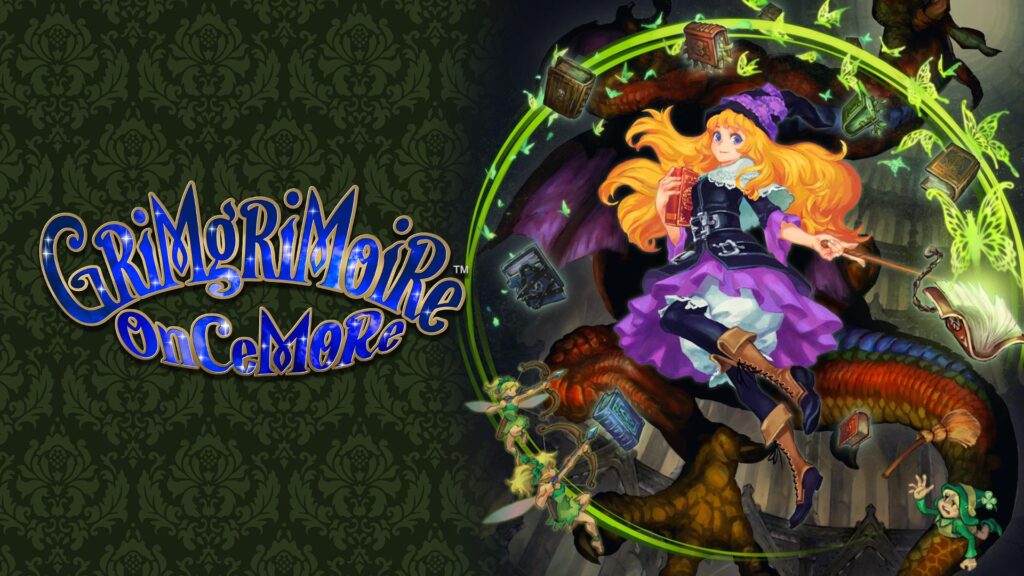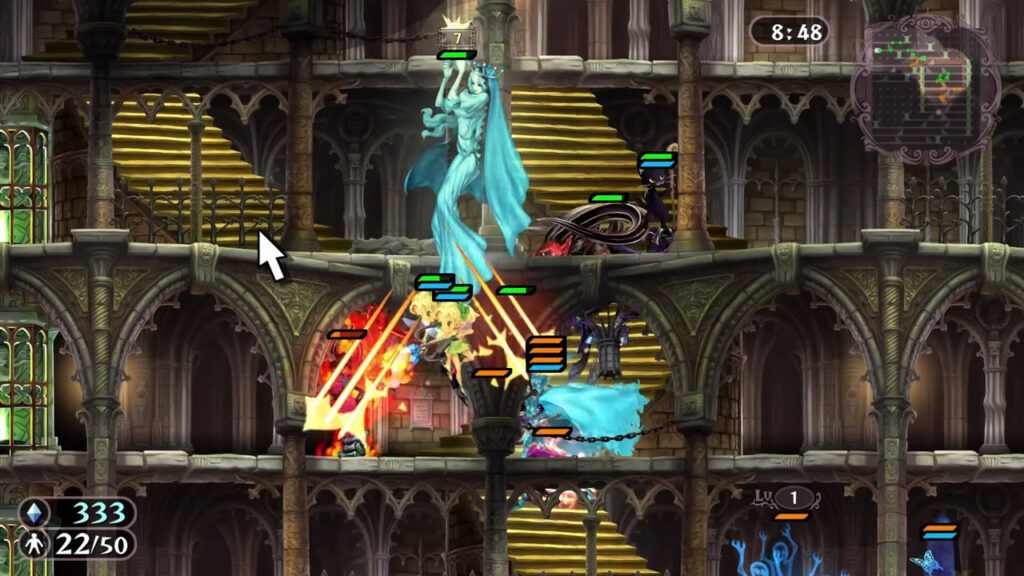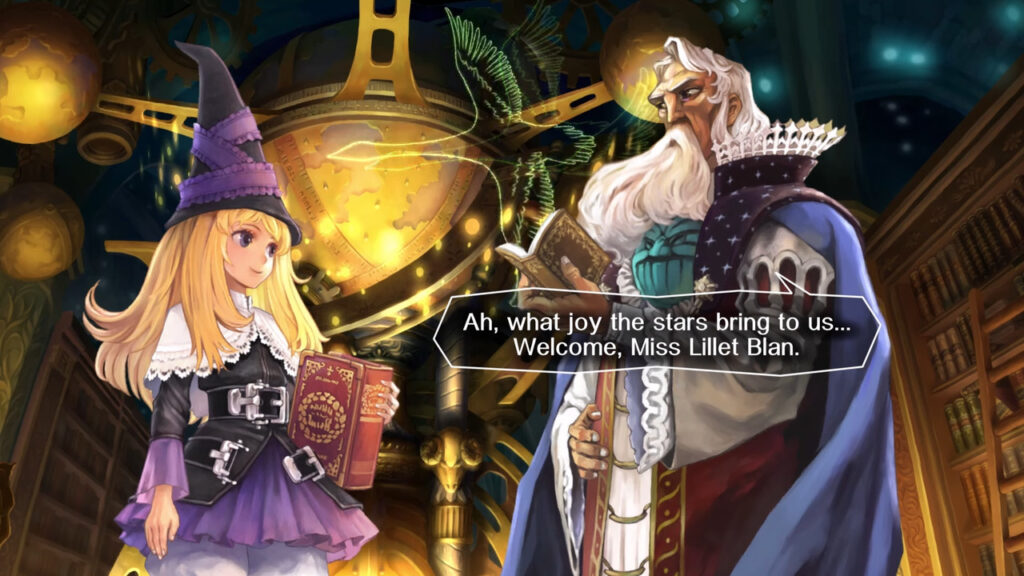
Developer: VanillaWare
Publisher: NIS America
Platform: Switch, PS4, PS5, PC
Tested on: Switch
GrimGrimoire OnceMore – Review
If you were to ask us when the season of the witch falls, we’d say in late October, around Halloween, but it seems video game publishers have a different idea. We’ve only just looked at Hogwarts Legacy, Bayonetta Origins, and Little Witch Nobeta, and we’re already getting another game that features a witch as its protagonist. This time around, the honor goes to GrimGrimoire OnceMore, a remastered version of Vanillaware’s PS2 title from 2007. So dust off your broom, grab your pointy hat, and summon your black cat, as we’re taking a look at what this classic RTS game has to offer.
Story
Things start out seemingly simple enough, with our protagonist Lillet Blan arriving at the Silver Star Tower. This massive tower houses an academy for budding witches and wizards, run by the not-so-subtly named wizard Gammel Dore, and Lillet is the latest apprentice to attend the curriculum. Everything goes fine during the first couple of days as Lillet gets settled at the academy and receives her first lessons in magic. Things go awry, however, when the archmage Calvaros escapes, after being sealed away in the tower for years. He goes on a rampage, killing everyone in the tower, including Lillet. It seems that her death isn’t necessarily permanent though, as our protagonist instead ends up getting stuck in a time loop. She now has to relive the five days between her arrival at Silver Star Tower and her untimely demise over and over again. In true Groundhog Day fashion, Lillet remembers previous instances of the time loop, but she is unable to divulge the details of the impending catastrophe to others. It’s now up to Lillet to break the time loop by using what she knows to influence the things happening around her, and eventually find a way to defeat Calvaros before he can kill her again.
Graphics
Visually, GrimGrimoire OnceMore is a bit of a mixed bag. The art direction is absolutely fantastic, with gorgeous hand-drawn character designs rendered in anime style. While character animation is very limited during the story scenes, which are presented in visual novel style, there is enough subtle variation in the character portraits to get character emotions across. There are also fantastic pieces of full-screen artwork visible during the story and additional artwork that can be unlocked. Unfortunately, the game falls a bit flat when it comes to the actual battles. The scenery in particular is bland and uninspiring, and although the game has definitely received a new coat of paint and doesn’t look like a PS2 game in the slightest, we do feel like more visual oomph could have been implemented to make the battles feel more impactful and exciting as the limited animations, obtrusive interface, and reused sprites make things feel flat and lifeless.
Sound
While GrimGrimoire OnceMore’s soundtrack isn’t anything to write home about, the voice acting is absolutely delightful. You can tell the cast is having fun by how hammy and over-the-top the performances are, in a good way. We don’t speak Japanese ourselves, but the tones of voice for certain characters are simply loaded with emotion and really help to bring everything alive. The sound effects are good too, with the different creatures providing a wide variety of growls, roars, and meows, and magic effects adding plenty of depth as well. Rather than remaster old files, the audio was rerecorded, and the end result sounds clear and crisp.
Gameplay
Before we dive into what GrimGrimoire OnceMore has to offer in terms of gameplay, we should clarify that we’ve never played the original, so we can’t outright compare what has been changed or added here compared to the PS2 version. From what we understand, the RTS gameplay has mostly stayed the same, with a handful of QoL features to bring the game in line with the expectations of modern-day audiences. These include a much-needed option to speed up battles, as well as the so-called Grand Magic mechanic, which, among other things, allows players to rewind the game to an earlier point in battle, similar to the Draconic Time Crystal mechanic from Fire Emblem Engage. These two features help with the game’s overall pacing, which is rather slow by modern standards. In addition, the game introduces a new mechanic in the form of a customizable skill tree that provides upgrades and buffs, which are purchased with coins that you earn by completing side missions. GrimGrimoire OnceMore ultimately feels like someone threw Harry Potter and Pokémon in a blender and sprinkled things with RTS mechanics.
Of course, the battles are the star of the show here, and although these certainly show their age in certain areas, the fundamentals are strong enough to keep GrimGrimoire OnceMore entertaining 15 years down the line from its original debut. Battles are fought on a 2D plane and are both fast-paced and lengthy affairs, often taking upwards of 30 minutes to complete if you don’t use the faster speed setting. Lillet herself never does any of the fighting. Instead, she uses her magical powers to summon familiars that face off against those summoned by her opponents. The battle mechanics are built around a rock-paper-scissors mechanic of sorts, with the different creatures that you can summon taking on different battle roles. Ghosts, for example, are weak to magic but immune to physical attacks, while demons are capable of dealing massive physical damage. If you want to succeed, you’ll not only need to ensure you have a good mix of different unit types on the battlefield, but you’ll also need to master the ins and outs of the different classes of magic that Lillet has access to. There is more depth to the game than just summoning the right type of unit and calling it a day too. Whether it’s summoning new familiars, setting up defensive structures, or crafting new runes, everything costs mana, so resource management is something you’ll need to keep an eye on.
There is plenty of tactical depth to be found here, with a wide menagerie of familiars, ranging from colossal fire-breathing dragons to cats that can put enemies to sleep. Given the rock-paper-scissors nature of the game, it’s important to keep track of which creature is capable of what, and this is easy enough early on in the game, but as new familiars were introduced, it became difficult to keep track of them all. Those fighting on your side are relatively easy to remember, but whenever new enemies are introduced, trial-and-error rears its ugly head. We found ourselves having to readjust our skill tree more than once after meeting our demise at the hands of a new enemy. Speaking of the skill tree, this is a mechanic that apparently wasn’t in the original game, which baffled us given how fundamental it feels. As we mentioned earlier, you’re able to purchase specific buffs and upgrades here. The interesting thing is that these purchases are not definitive, and you’re able to redistribute any coins spent in between battles, so you can optimize your buffs depending on which opponent you face.
Perhaps the game’s biggest weakness in terms of gameplay are the map designs. The game is set in a single location, the Silver Star Tower, and there is only so much that can be done within that setting. Add to this that the game is built around a time loop, and it doesn’t take long for repetitiveness to kick in. That’s not to say that the game is boring by any means, because the tactical aspect is fundamentally enjoyable, but more variety in map designs would have been more than welcome here, as the differences between maps were a bit too subtle to our liking. Even the so-called Trial Stages, which set specific win conditions don’t change enough to really spice things up. We’d recommend tackling GrimGrimoire OnceMore in short bursts rather than lengthy sessions to keep the game from becoming stale, as it is a perfect palette cleanser in-between other games. It’s not a very long game in the first place anyway, with our playthrough clocking in at around 15 hours, so perhaps this is a title that simply needs to be savored rather than binged.
Don’t be put off by that seemingly short runtime either, as despite the repetitive nature of the maps, there is plenty of replayability to be found here. The game offers three distinct difficulty levels, with specific unlockable skills only available at higher difficulties. You’re also incentivized to complete all the aforementioned Trial Stages, which reward you with exclusive artwork on top of coins used for further upgrading your skill tree. There’s also the so-called Hell Mode, which unlocks after clearing the game, for those looking for an extra challenging version of the game. Ultimately, you’re getting plenty of bang for your buck here, even if the game’s PS2 legacy shines through. Perhaps returning to the GrimGrimoire universe would have been even more enjoyable had this been a sequel or reboot rather than a remaster with a handful of QoL improvements. As it stands though, there is still plenty to love here, just in bite-sized chunks rather than as a full-sized meal.
Conclusion
The repetitive map design and relatively slow pacing prevent GrimGrimoire OnceMore from truly reaching its full potential, but the game still deserves its time in the spotlight. The RTS gameplay is enjoyable and the sheer variety of familiars, combined with the customizable skill tree ensures that there is plenty of tactical depth. The story is engaging enough to motivate you to keep playing, and completionists certainly have their work cut out for them if they want to unlock every available piece of artwork. GrimGrimoire OnceMore may not be a must-have title, but if you do decide to enroll at the Silver Star Tower, you won’t end up disappointed either.
GrimGrimoire OnceMore - Review,









No Comments